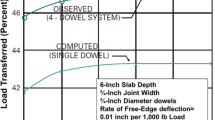Abstract
Joints in jointed concrete pavements are artificially designed discontinuities to control the natural cracking with slab movements caused by changes in temperature and moisture conditions. However, considerable portion of joints are not cracked in practice. In this study, joint-uncracking phenomenon are categorized by two patterns, prior mid-slab cracking pattern (Case A) and low tensile-stress pattern (Case B). Prior mid-slab cracking pattern indicates that mid-slab cracking occurs before saw cutting at joints and joints remains as uncracked. Low tensile-stress pattern indicates that some portions of joint are cracked and others remains uncracked without mid-slab cracking since tensile stress, developed by subbase friction and curing, is lower than minimum stress to crack at joints. The causes of and frequencies of joint-uncracking are investigated in a number of jointed concrete pavements (JCP) in USA and Korea. The uncracked joints result in longer-concrete-pavement slab than the designed. In this study, the effects of uncracked joints such as the erratic large joint opening and excessive slab stress are explored.
Similar content being viewed by others
References
Bodosci, A., Minkaraha, I.S., and Rajagopal, S.A. (1993). “Analysis of horizontal movement of joints and cracks in portland cement concrete pavements.”Journal of Transportation Research Record 1392, pp. 43–52.
American Association of State Highway Transportation Officials (1986).AASHTO Guide for Design of Pavement Structure, AASHTO.
McCullough, B.F. and Rasmussen, R.O. (1999). “Fast-Track Paving Concrete Remperature Control and Traffic Opening Criteria for Bonded Overlays.” Vol. II: HIPERPAV User’s Manual,FHWA-RD-98-168, U.S. Department of Transportation, FHWA.
Darter, M.I. and Barenberg, E.J. (1992). “Design of zero maintenance plain concrete pavement, VOL. II-Design manual.”FHWA-HI-92-105, U.S. Department of Transportation, FHWA.
Lee, S.W. (2001). “Behavior of concrete slab under frictional drag.”Journal of Civil Engineering. KSCE, pp. 1–10.
Lee, S.W. and Stoffels, S.M. (2002). “Effects of excessive pavement joint opening and freezing on sealants.”Journal of Transportation Engineering, ASCE, Vol. 129, No. 4, pp. 444–450.
Lee, S.W. and Stoffels, S.M. (2001). “Analysis of in-situ horizontal joint movement.”Journal of Transportation Research Record 1778, pp. 9–16.
Author information
Authors and Affiliations
Corresponding author
Rights and permissions
About this article
Cite this article
Chon, B.J., Lee, S.W. Effects of uncracked joints in jointed concrete pavements. KSCE J Civ Eng 11, 141–144 (2007). https://doi.org/10.1007/BF02823893
Received:
Accepted:
Issue Date:
DOI: https://doi.org/10.1007/BF02823893



